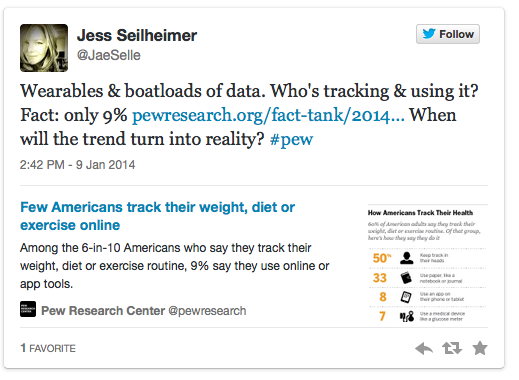We’re always chasing the shiny bouncing ball.
Not sure how many more “trend” posts I can take (especially decks titled “100 trends for 2014!”). What? Are you looking to make me pass out? And well, that’s not very directional vs. a dump of “cool stuff.”
Many people confuse tactics and trends. Case in point: Snapchat is not a trend. It’s a social platform, a social tactic (some of which are poorly thought out, in my opinion). Bloomberg. ON Snapchat? When the demographic is teenagers/young adults who use the app to…. Well, you know what…. and to share private stories they otherwise wouldn’t publically. Following where I’m going?
Hmmm.
Side note: Snapchat goes against everything social is meant to be. Viral. Sharable. Enduring. But, Snapchat introduced disappearing media, which is getting tons of buzz. Just not sure that’s where marketers want to play. Not really an opportunity for amplifying/enduring your message across your audience’s social graph. Possibly the only use would be for loyalty, or a sneak peak into a new line of makeup like Nars did. Maybe for fashion or a TV/movie clip— but other than that…I don’t know that I see much use for it.
Kind of sounds like the QR Code to me. Great in theory, but um, well. You know what happened there.
Snap! I got off topic, lets talk about marketing trends!
2014: The Year Marketing Trends Matured
I’ve been sensing people looking, searching for trends and things to write about—mostly because there aren’t really “new” trends being uncovered… The trends that we saw last year are being slightly reimagined and are maturing this year—and that’s a good thing. It allows us to process, learn and make informed decisions.
In this post I’m covering 4 marketing topics:
- Tech
- Healthtech (b/c it deserves a separate topic)
- Social
- Analytics
Tech
Boo hoo to CES go-ers and their tech-tastic letdown. Sorry you feel there wasn’t even 1 big tech standout product at CES—that’s a GOOD thing. CES is a prototype circus—2013 was the year of many hardware prototype and trends (wearables, smarthome, healthtech just to name a few).
This year we saw many of the same tech trends as last year, but in a more matured state.
Commercializing hardware takes time—market entrances are faster than in years past thanks to agile development and whatnot—but the cycles are still looooong. For instance, if you have smart refrigerators and laundry machines and cooktops and self charging bowls… I love the concept—but how can manufacturers anticipate what mobile OS’s will be capable of 2-3 years from now? Are all those new cool gadgets/tech– still viable if they own their own UI/UX? Not sure. Maybe. Possibly with an expensive rework. Smart manufactures will integrate with existing mobile OS’s (vs. creating their own) for fear that they will be obsolete when mobile OS changes, which happens frequently.
When you synthesize the commonalities amongst all those products across multiple verticals-
“The trend: the control of many devices will be collapsed into your mobile phone— “Universal Connectivity” (for those that prefer to associate my analogy with buzzwords—please Google the internet for such things).”
Let us not forget drones! Quite possibly the biggest tech tease of all, thanks to Amazon. Do you know that commercial drone flights will remain illegal in the U.S. for the next few years? Bet you didn’t. But, Amazon got you believing they’d be delivering your next mixed bag of treats, like tomorrow. Oh PR—what a powerful tool you are.
Subtopic: Brand/Tech Partnerships
Some tech trends are slow to roll with the mass audience (some marketers as well) such that we find the same slow adoption when looking at how brands enter into marketing innovation: Experimental partnerships with emerging startups and technologies to uncover new marketing opportunities. This topic has been covered a lot as of late—some POV’s claiming there is no room/time/place for startup partnerships. That these brands should get back to the basics. I disagree. I don’t think this is the time for brands to take a tech break from being overwhelmed. There are new service indexes and platforms like Cuurio and Kite. These platforms can be a marketer’s (or agency strategist’s) best friend—cutting through the clutter helping to make innovative, strategic decisions.
Technology will always be emerging and finding ways into our mainstream lifestyle. But, as long we remember things like this, perfected in a tweet earlier this morning, we’ll all be in good shape.
Some things may be ahead of their time—but some will solidify themselves into everyday necessity like the iPhone and Roku (hail hail Roku!).
Patience is a virtue.
Healthtech
I’ve been covering healthtech since “healthtech” moved beyond a diagnostic tool like a blood test, and became a viable market opportunity and gained enormous entrepreneurial interest due to massive innovation in 2010. According to Rock Health, (my go-to source for all things healthtech) their 2013 End of Year Report shows 39% growth in digital health private funding for 2012.
I also see maturity in this vertical. First-time healthtech entrepreneurs who thought they could enter this space with no prior knowledge of how the FDA regulates medical deices; What was considered a 510K approved medical device vs. a wellness app has dwindled- thank god. I’ve lost count of the amount of healthtech accelerators at this point, but the good ones are backing some great companies made up of seasoned healthcare professionals—many clinical, technical scientists and institutional alums who understand the politics, commercialization methods and most importantly the benefit of leveraging evidence based studies to support their efforts.
Many companies are still focusing on consumer facing gadgets that will improve your life. But, the bigger theme here is data and analytics, (responsible for 161M in digital health funding) and the companies (even providers like Aetna) who are focusing on how to make your collected passive data more active and useful.
“The trend: Collect my data in one place and tell me what to do with it— “Actionable Wellness”.”
I love my Misfit Shine, My Fitness Pal, Map My Ride, Pact, Sleep Cycle… But, it’s a big time and behavior commitment, and none of them tell me how I can make my data actionable or improve upon it. I’m ready for something that combines them all together!
Social
Established social platform use will steady out amongst consumers— leaving room for emerging platforms of course, but I don’t think we’re going to see the hockey stick growth patterns of years past. Because of that, brands will be able to take a time out, recount the successes/failures of their pilots from 2013, get their footing and most importantly the appropriate BUDGET, according to a survey from cmo.org.
I think we’ll see:
- Investment in customer insights and analytic software
- Social diversification: matching content and cost to the right platforms/consumers
- Marketing leaders will gain additional headcount, hire talented individuals (vs. interns) and integrate social into their discipline
- Measuring (and making sense of) quality engagement metrics vs. only quantitative ones
The winners will be the ones who invest in quality talent to collect the right insights to keep their audiences engaged across multiple platforms (desktop, mobile, tablet). More expanded reading on that from the Altimeter Group here.
The trend: Building marketing efforts around shifting and sometimes transient customer behaviors — “Marketing For a Social World”.
Additional great required reading in this piece from Harvard Business Review: What’s the End Game for Social?
Learn more at Social Media Week New York February 17-21 at the Highline Stages. A great lineup and all in one place this year!
Analytics
What’s new and sexy in marketing? Not much, tactic-wise. But, analytics is a sexy strategy. As unattractive it sounds, data and analytics should be at the top of your list. Problem is, not many marketers are well equipped to tackle this. Not because they aren’t smart—but because they don’t know what they don’t know. Ever heard the term “data analysis paralysis?” I think companies will finally move beyond that and fuel their team with a diversified mix of technologies to centralize it, so then the data scientists can make sense of it.
Organizationally, companies will move from questions like “who owns it?” and “who funds it?” to the next phase of change management: “who gets to see it, change it, and who can administer it?”
One of the best quotes I’ve read from Harvard Business Review’s latest post: “The practical conclusion is that we should turn many of our decisions, predictions, diagnoses, and judgments—both the trivial and the consequential—over to the algorithms. There’s just no controversy any more about whether doing so will give us better results.”
The trend: “Turning marketing from an art into a science — The Analytical Advantage ”.
CMO’s will prioritize and outsource the right analytics group/team to partners like Splunk, Domo or Tableau. An attribution model represents the Holy Grail in marketing—knowing precisely which marketing activities (tactics) lead to achieving your marketing goals
Data dominated companies will quickly win over old school “gut instinct.”
When to Jump In
Trends should be used as a professional horoscope. Guidance to what’s on the horizon. Preparing you on what to look out for. Nothing more, nothing less. If you’re able to stay aware of and identify trends relevant to your line of business, you can stay flexible and plan for advancements.
Coincidentally I’m an Aquarian— textbook curious mind, futurist and tech enthusiast. Ha. Still doesn’t mean that tomorrow I’m going to suggest that all retail brands enable distribution via drones—but when I find out the timing of your commercial cycle you bet I will. Sorry Fedex- you’ve been good to me but I’m on to the next.
Image credit: CC by snigl3t







